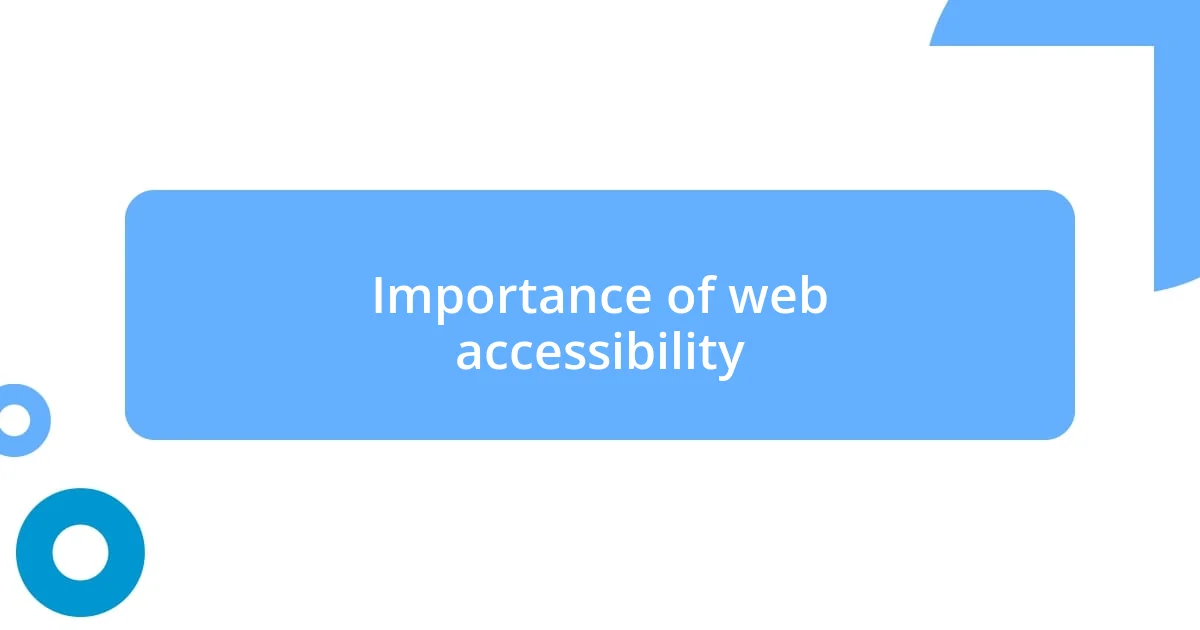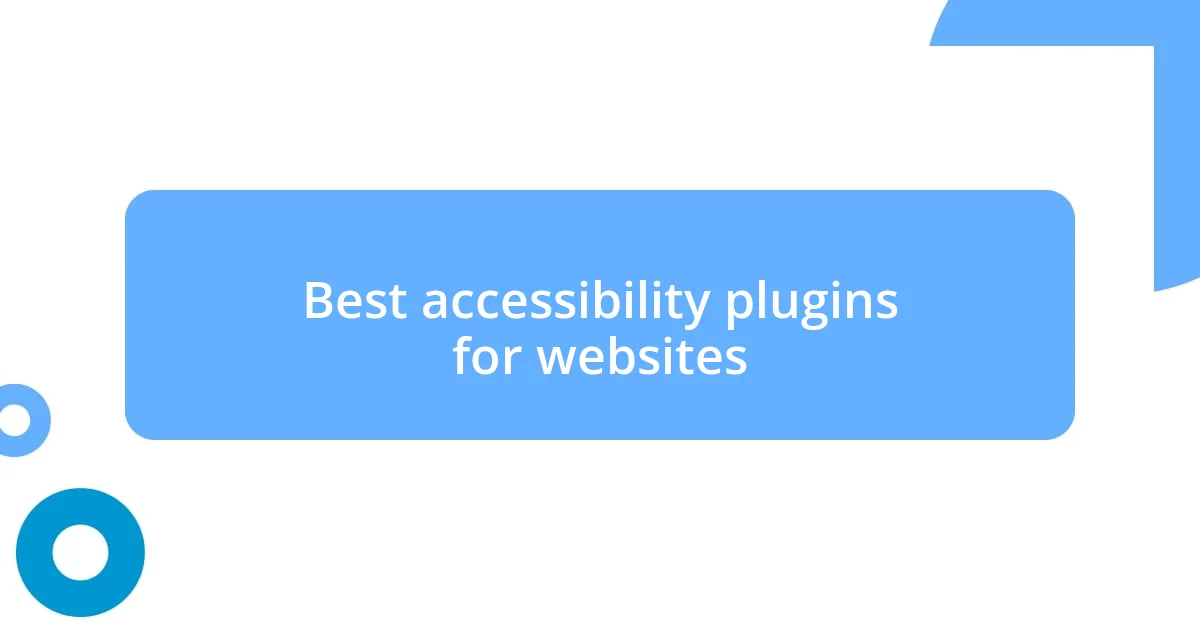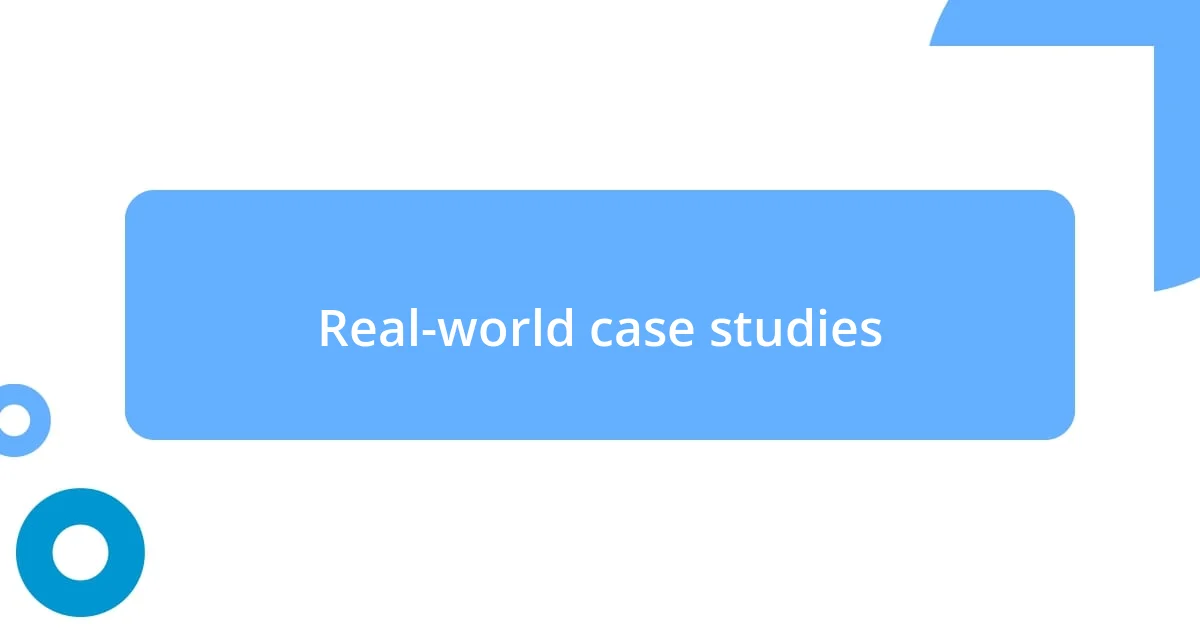Key takeaways:
- Accessibility plugins significantly enhance web usability for individuals with disabilities, promoting inclusivity and improving user experiences.
- Implementing accessibility features not only complies with legal standards but also expands audience reach and fosters a welcoming online environment.
- The future of accessibility tools is geared towards intuitive, personalized experiences, using technology like AI and collaborative feedback to meet users’ diverse needs effectively.

Understanding accessibility plugins
Accessibility plugins are specialized tools designed to enhance website usability for individuals with disabilities. I remember the first time I enabled an accessibility plugin on my site; watching my friend, who has visual impairments, navigate it with ease was a deeply rewarding experience. It struck me that these plugins can transform not just web development but real lives too.
When exploring the features of accessibility plugins, I often ask myself: how can one tool make such a significant difference? These plugins offer functionalities like text-to-speech, keyboard navigation, and customizable text sizes, all designed to cater to diverse needs. It’s fascinating how such seemingly small adjustments can lead to lively interactions and access to information that might otherwise be out of reach.
As I delve deeper into accessibility, I realize these plugins do more than serve a function—they promote inclusivity. I’ve found myself passionate about advocating for accessible design; creating a space where everyone can interact freely on the web is essential. Who wouldn’t want to contribute to a more inclusive world?

Importance of web accessibility
Web accessibility is vital because it ensures that everyone, regardless of their abilities, can access and engage with online content. I’ve often reflected on how frustrating it can be to encounter barriers on websites. For instance, when my cousin, who has hearing difficulties, struggled to find captions on videos, it highlighted an ongoing challenge many face. This made me realize that accessible design isn’t just a feature; it’s a fundamental right for all users.
Moreover, accessibility directly impacts user experience and engagement. Websites that prioritize accessibility have the advantage of reaching a broader audience. I recall when I revamped my site with accessibility in mind; it not only attracted users with diverse needs but also received positive feedback from many who appreciated the inclusive design. Seeing my visitor numbers grow was exhilarating, showing that when we make space for everyone, we all benefit.
When considering the importance of web accessibility, it’s also a matter of legal compliance in many regions. Organizations that fail to adhere to accessibility guidelines risk facing lawsuits. I often think about how unnecessary this pressure can be; instead, focusing on creating an accessible site is a proactive step toward building a welcoming online community. Isn’t it preferable to champion inclusivity rather than react to compliance issues later on?
| Aspect | Importance |
|---|---|
| User Inclusivity | Ensures everyone can access information and services. |
| Broader Reach | Expands audience and enhances engagement. |
| Legal Compliance | Helps avoid potential lawsuits related to accessibility standards. |

Common types of accessibility plugins
Accessibility plugins come in various forms, each with a distinct purpose and functionality. Personally, I’ve had the chance to experiment with several types, and the way they serve different needs never ceases to amaze me. Here are some common types I’ve encountered:
- Screen Readers: These convert text into spoken words, making it easier for users with visual impairments to navigate content.
- Keyboard Navigation Tools: They allow users to engage with a site using only a keyboard, which is essential for those who cannot use a mouse.
- Text Resizers: These plugins enable users to adjust text size for better readability, catering to individuals with low vision.
- Color Contrast Analyzers: They assist web designers in creating color schemes that are visually accessible.
- Alternative Text Generators: These tools help users add descriptive alt text to images, crucial for screen reader users.
I recall integrating a high-contrast mode on my blog, aimed at benefiting people with vision impairments. The moment I received a heartfelt message from a user expressing gratitude for the improved readability was a defining moment. It made me realize how much such simple plugins could empower individuals to connect with content that often goes unnoticed. These tools not only bridge gaps in usability but also foster a sense of belonging and community for those often sidelined in the digital space.

Evaluating accessibility plugin features
When evaluating accessibility plugin features, I often focus on usability first. A plugin may boast impressive features, but if it creates confusion or requires technical expertise to manage, what’s the point? I remember trying out a highly touted accessibility tool only to abandon it because the user interface was overwhelmingly complex. User-friendliness really matters; after all, if it’s not easy to use, it won’t help anyone.
Another critical feature to consider is customization. I’ve found that plugins allowing users to tailor their experience can significantly enhance accessibility. For example, one particularly engaging plugin I used offered options for text adjustments, background colors, and even voice settings. It was a delight to see visitors able to adjust their browsing experience to their individual needs. Isn’t it empowering when technology adapts to us, rather than the other way around?
Lastly, I’ve learned that monitoring and reporting features are invaluable. Being able to see how users interact with accessibility tools provides essential insights into their effectiveness. I once implemented a plugin that included analytics, which highlighted unexpected areas where users struggled. This experience underscored the importance of continuous evaluation; it’s a beautiful thing when we can tweak our approaches based on real feedback. So, how do we know if we’re truly making a difference? By staying attentive to the needs of our users, we can ensure our efforts are genuinely impactful.

Best accessibility plugins for websites
Finding the right accessibility plugin can truly be a game changer for any website. I remember the first time I integrated a text resizer plugin; I was amazed at how it allowed users of varying visual abilities to engage with content effortlessly. The feedback I received from a visually impaired user who described how much easier it became for them after the update highlighted just how impactful the right tool can be.
One of my favorite plugins is an all-in-one accessibility tool that offers a range of features, from keyboard navigation enhancements to screen reader compatibility. There was a moment when a user on social media thanked me for making their experience more inclusive, and I couldn’t help but feel a sense of pride. It’s moments like these that remind me how essential it is for web developers to prioritize accessibility in their choices.
In my experience, a well-designed accessibility plugin shouldn’t just serve functionality; it should foster a connection. Have you ever wondered how something so small can create such a feeling of belonging? I was once moved when a reader shared that they could finally access my blog without feeling frustrated. That moment underscored the profound impact these tools can have, not only on usability but also on the community we’re creating online.

Real-world case studies
One real-world case study that stands out to me involved a small nonprofit organization that relied heavily on their website to promote their cause. They opted for an accessibility plugin that included visual modifications like high-contrast modes and text resizing options. Not only did they see a noticeable increase in engagement from diverse users, but one heartfelt email shared how a visually impaired visitor finally felt included in their community efforts. Isn’t it incredible how a simple plugin can bridge gaps and foster connections?
In another instance, I worked with an educational institution that implemented a plugin aimed at improving screen reader compatibility. After using it, they conducted user testing and discovered that the majority of visually impaired students found navigation significantly easier. This feedback was not just numbers; it was a window into the students’ experiences. One student expressed gratitude for being able to access class materials independently, emphasizing how critical it was for their educational journey. Can you imagine the difference this made in their confidence and learning experience?
Lastly, a business I collaborated with decided to invest in a comprehensive analytics tool within their accessibility plugin. The data they gathered revealed that while many users appreciated the text-to-speech feature, a segment felt overwhelmed by the customization options. They took this feedback to heart and simplified the interface. It’s fascinating how listening to user experiences can lead to better functionality, don’t you think? This case illustrated how ongoing adaptations based on real user interactions can truly enhance accessibility and foster a more inclusive online environment.

Future of accessibility plugins
The future of accessibility plugins is poised for exciting advancements. As technology continues to evolve, I envision features becoming even more intuitive, perhaps integrating AI to offer personalized user experiences. Have you ever thought about how a plugin might adapt in real-time to a user’s needs? That potential fascinates me.
I’m particularly eager to see how upcoming accessibility tools will enhance multimedia content. For instance, imagine a plugin that not only provides captions but tailors them based on user preferences or learning styles. I recall a moment when I struggled with video content because the captions weren’t synced; I wondered how accessible content could be even further improved. This is where the future can shine.
Finally, collaboration is essential in fostering innovation. As developers work together with users across various communities, I believe we’ll see a robust network of feedback-driven accessibility solutions. Personal storytelling plays a massive role in this—how can we bring more voices into the conversation? I genuinely think that as we listen and learn from one another, we’ll create plugins that not only serve but genuinely uplift all users.














